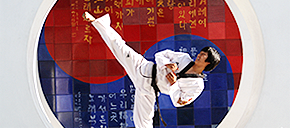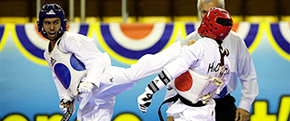TAEKWONDO
Introduction
Taekwondo is a martial art form and sport in which fighters use their hands and feet for attack and defense. The focus of this martial art is on training and disciplining the mind along with the body. Taekwondo plays four different roles for its learners.

- First, Taekwondo as an Exercise
- Taekwondo is a good exercise for children who are still growing as well as a good way for grown-ups to increase their physical endurance. Taekwondo's movements require extensive use of the joints, which increases the limberness of one's body. Since there are kicking, jabbing and shouting involved, it's also a great way to relieve stress and get a good workout.
- Second, Taekwondo as a Bare Handed Martial Arts Form
- Taekwondo learners attack the opponent with their bare hands and feet. What sets this apart from other martial arts forms are the powerful and various leg movements involved, and which have enabled it to become a worldwide martial art. Taekwondo's attack is aggressive, but at the same time the focus is more on the defense aspect. This can act positively for those wanting to learn Taekwondo as a way of self defense for practical purposes, even in modern times.
- Third, Taekwondo as a Sport
- Taekwondo is an official competitive category in major world sporting events such as the Olympics, Panam Games, Asian Games, All American Games, and South American Games. Competitive Taekwondo involves safety gear and set attacks and defenses as to limit the amount of damage possible. This way, competitive martial artists can enjoy the thrill of competing with less risk.
- Fourth, Taekwondo as an Educational Method
- Taekwondo trains the body, but does as much to develop the mind as well. The objective of learning Taekwondo is to foster growth in both areas in order to become a more mature human being. Taekwondo learners receive repeated etiquette lessons along with the attack and defense skills to build and strengthen their character.
History

The roots of Taekwondo belong to Taekkyeon, a traditional martial art form. In turn, the roots of Taekkyeon can be traced as far back as tribal times in Korea. Taekkyeon has been known under different names throughout the ages and quickly grew during the age of the three kingdoms (a period during the 4th to 7th century when the Goguryeo, Silla, and Baekje Kingdoms fought with each other for dominance of the Korean peninsula). Taekkyeon later saw more development and evolution during the Goryeo era (918-1392), a time in which those skilled in the military arts were highly respected. During that time, Taekkyeon was used as a determining factor for promotions in the military. Things changed, however, with the arrival of the Joseon era (1392-1910), in which the art began to be viewed as a low form of fighting. As a result, Taekkyeon slowly receded into obscurity. Currently Taekwondo, a descendent of Taekkyeon, is embraced as a world-class sport as a result of the painstaking efforts of many individuals.
Taekwondo Belts
| Level | Pumsae | Belt Color | ||
|---|---|---|---|---|
| ㆍLow Level | Level No. | Basic Position |  |
|
| Level 8 | Taegeuk 1-Jang |  |
||
| Level 7 | Taegeuk 2-Jang | |||
| Level 6 | Taegeuk 3-Jang |  |
||
| Level 5 | Taegeuk 4-Jang | |||
| Level 4 | Taegeuk 5-Jang |  |
||
| Level 3 | Taegeuk 6-Jang | |||
| Level 2 | Taegeuk 7-Jang |  |
||
| Level 1 | Taegeuk 8-Jang | |||
| ㆍHigh Level | 1 Pum, 1 Dan | Goryeo | Pum | Dan |
| 2 Pum, 2 Dan | Geumgang |  |
 |
|
| 3 Pum, 3 Dan | Taebaek | |||
| 4 Pum, 4 Dan | Pyeongwon | |||
Taekwondo Festivals

- The World Taekwondo Hanmadang
- World Taekwondo Culture Expo
- Chuncheon Korea Open International Taekwondo Championships
- Chungju World Martial Arts Festival
- World Taekwondo Festival & Korea Classic Open



 INTERNATIONAL
INTERNATIONAL